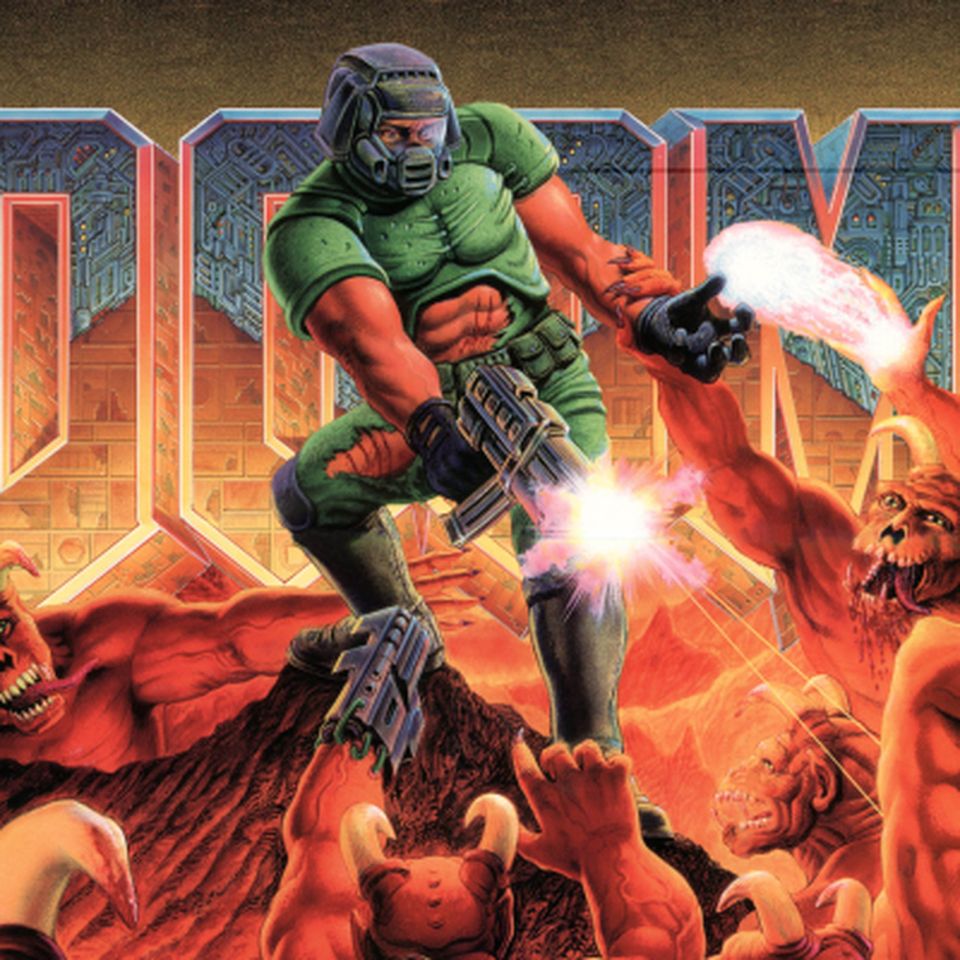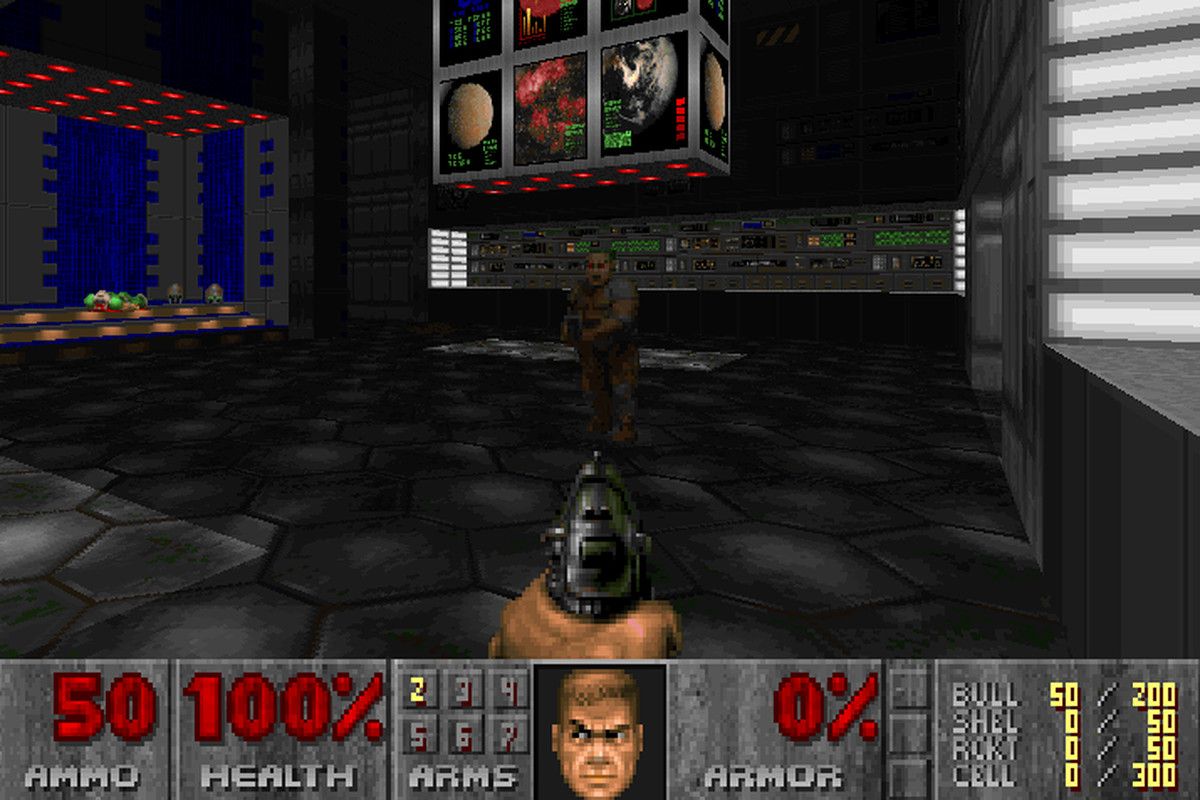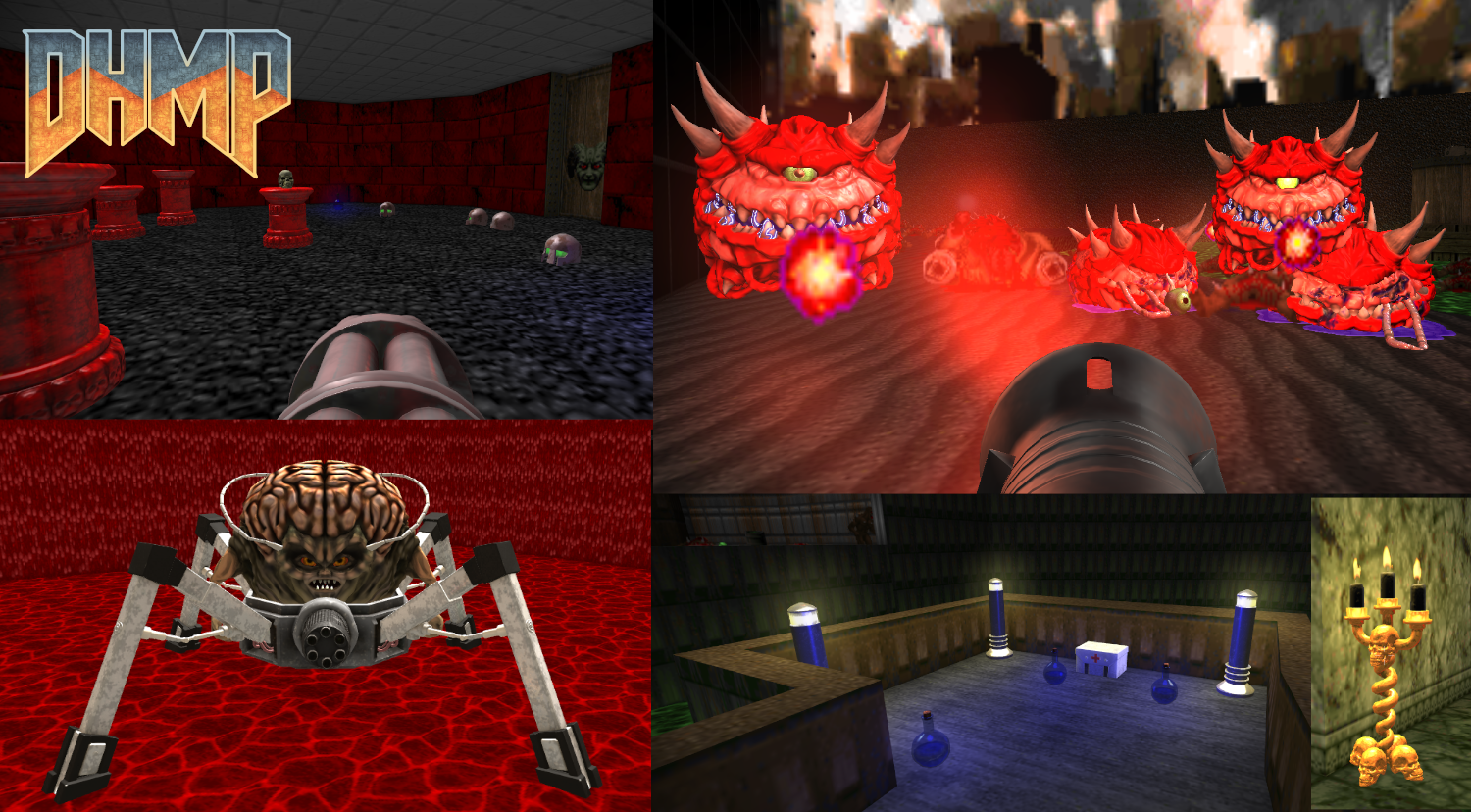Remembering the original Doom game

Even if you invest a small fraction of your time in gaming, you will surely have heard about Doom, released in 2016. The truth is that Doom is a game initially released in 1993 by ID software, and is considered to be the grandfather of the First Person Shooter Genre.
Let’s take a short trip into its history, its evolution throughout the years (yes, it has evolved) and its community. We will also look at some of the community’s creations and how they shaped today’s industry.
I remember playing this a long time ago when it first came out. I was seven years old back then, and I was already playing games on my computer, a Mac LC475, with a processor capable of running at 25 MHz, with 12 Mbytes of RAM. It wasn’t the best of its time, but it did the job.

When Doom was released, it made the world forget what gaming was before it. It was so popular that it had become a problem at workplaces, with many companies (such as Intel) banning it from their computers and networks.
Doom built on top of concepts first presented in Wolfenstein 3d, originally released in 1992. New textures were added, better enemy AI, a skybox, open spaces, stairs, numerous door types… But what Doom brought to the table was something more than the sum of its parts; It was the sense of horror while playing it, and the addictive free-for-alls (by the way — it was Doom that standardized the term “Deathmatch”).
Those hellish graphics, non-stop action, and mindless survival killing were new at the time, and triggered wide critical acclaim, and (of course) some controversies due to its graphic violence.
Doom has been ported to all kinds of devices known to humans, including NeXTSTEP, Solaris, Linux, Sega 32X, Atari Jaguar, SNES, PlayStation 1–3, XBOX, iOS, Android… you name it. It has even been ported to the original iPod nano.

The original Doom was followed by Doom 2, which used the same engine and introduced 30 new levels, new weapons, and enemies. Final Doom, was then released in 1995 and included two 30+ level megawads, The Plutonia Experiment, and TNT Evilution.
Doom has been the subject of many documentaries trying to examine the source of its success and addiction it brought to the players. More than 27 years later, the community around Doom is alive.
Doom Community
ID Software paid extra attention to modding support for Doom. Doom stores its content (monsters configurations, assets, maps, etc.) inside a file called WAD (Where’s All the Data). The main application would look known locations for WAD files and load the content from there. Externalized resource files sound like a very straightforward process, but back in 1993, it was phenomenal and extremely uncommon. Doom was the first game to provide full extensibility through modding and set a clear precedent for future games.
On December 23, 1997, ID Software released the Doom’s source code to the public (you can now find it on GitHub).
Having extensive mod support and its source code released, it didn’t take long for the community to take over.
There is an extensive (but not complete!) list of Doom source ports in Wikipedia, so I won’t bother you by repeating this list here.
Doom Source Ports
The year is 2020, and now we have ultra-fast computers and dedicated graphics cards. What is the best way to play the original Doom in 2020?
The answer is: It depends on what you are looking for. Let’s take a look at a few of the most famous source ports of Doom, and what they can offer in 2020.
Chocolate Doom
Chocolate Doom is Doom for purists. It's a port of the game for 2020, but with the look and feel of 1993, bringing the Doom experience as close to the original as possible. On the website there are pre-built Windows executables, but if you are on Mac or Linux, you have to build the binaries yourself.
If you want to play Doom the way it was designed to be played, the best way to do this is using Chocolate Doom.
Doomsday Engine / Risen3D
The Doomsday Engine is an ambitious project aiming at improving the Doom experience by adding a few great features on top of the original Doom offerings:
- Improved texture rendering, by not only applying anti-aliasing to textures but by implementing smart texture rendering, which goes one step further ahead of eliminating square pixels.
- Dynamic lighting
- 3D models
- A scripting language for modders to write custom actions/actors and implement features not present in the original Doom game.
- Support for high-resolution textures
Regardless of the extensive feature set, you can disable all those features and have an experience closer to the original Doom.
Regardless of the extensive feature set, you can disable all those features and have an experience closer to the original Doom.


New doom with 3d Models
Doomsday has given me hundreds of hours of joyful Doom playtime. However, I have to admit that the gameplay in Doomsday was not the one I was experiencing in other source ports. I mean — the responsiveness of the buttons, the way the mouse was made the character look. Maybe it was my idea — but in terms of pure gameplay (movement, aiming), I found other source ports to be slightly superior. But then again, that’s my preference.
One of the best things that Doomsday has to offer is that the developers provide links to additional content like High Texture and 3D models pack in the main site. This is extremely useful, especially if we take into account the ridiculous number of addons packages available in the modding community, which may or may not be compatible with the source port you use.
The user interface is very good, the support for OS X and Linux is excellent, and it is still under active development. Overall, it is something that you should try if you are getting started using the Doom source ports.
Doom Legacy
I began investing time into source ports in 2006. I started using Doom Legacy because it seemed to me that its responsiveness regarding the controls and the general gameplay was better than Doom Legacy. Back then (2004), I couldn’t set the 3D models and all the bells and whistles that Doomsday had to work properly. Its contribution to the community was great. However, providing 3d floors, a two-player split-screen, and a scripting engine.
But when it came to using plain old 3D sprites, its rendering looked a bit better, and the gameplay was more responsive than Doomsday’s, which made me stick to it for a while.
Doom Legacy’s development stalled in 2004. It continued in 2010, and the source code under development in 2020.
It has first-class support for Linux and Windows; OS X users will encounter some issues with the latest builds ( back in 2004, the OS X builds were flawless).
Zandronum
Since I only want to play DOOM in single-player mode, I haven’t invested much time into Zandronum. However, I can say that if you’re going to play some good old deathmatches, this is the port you should go with.
Zandronum is the de-facto standard for playing Doom multiplayer matches.
GZDoom
I saved the best for last.
GZDoom is, by far, a source port with the most vibrant community. It is modder-oriented, which means that it has better support for scripting systems allowing the modders to implement features to their heart’s content.
Which is why most modern mods being tested to run on GZDoom — other source ports come second. Some features include:
- Support for 3D models
- Dynamic lighting
- Advanced texture and sprite filtering
- Extremely customizable
- Easy to setup.
My only gripe with GZDoom is that it could have a better launcher for OS X. It’s nowhere near the quality of Doomsday — but it’s a small price to pay for something that gives you access to almost every mod available today.
In terms of graphics capabilities, this is how far it can go (ignore the RTX in the title — that’s a misleading title by the developer of the mod).
A currently banned (for good reasons) mod, which showcases the capabilities of the engine — and how far the community has progressed. Not bad for a game released in 1993, huh?
A currently banned (for good reasons) mod, which showcases the capabilities of the engine - and how far the community has progressed. Not bad for a game released in 1993, huh?
Where to get some content?
Now you know that the Doom community is alive and kicking, and you want to play some Doom, right?
First of all, let's get the obvious stuff out of the way - which source ports should you choose? Well, I can't recommend GZDoom enough, so you should start with that first.
If you want to play Doom, you will need to have bought the original game to use its wads (the maps, textures, etc.). If you haven't done that, you will need to buy Doom at GOG, Steam, or elsewhere. You also have the option to download Freedoom and use it with your source port, a free content game based on the Doom engine.
So, now that you have GZDoom, and Doom 2. Open your GZDoom, load GZDoom, and in the "additional parameters set the -file <<my_wad_file_name>> and hit play. This will load Doom 2 as the base content, and also load every other content from the wad file declared as the argument. Note that you can also combine mods together. Thus, you can load a megawad for maps, and another mod conversion, like Brutal Doom.
I believe I should now briefly mention some of the mods that have kept me returning to playing Doom again and again. Please note that this is by far an indication of the diversity of the Doom community. It’s just a personal collection of preferred assets/mods that will hopefully provide a good introduction to someone playing Doom using a source port for the first time.
The Ultimate Torment & Torture
There are too few map /monster packs that made me have so much fun such as this one.
The maps are well-thought, there are some new monsters, many new assets. I believe this is what a new episode of Doom would look like.
Download: TUTNT Supportive Edition zip, TUTNT Original pk3
ZPack
ZPack was created by the members of the ZDoom community. It takes advantage of features specific to the GZDoom engine, thus you will find features and scripted elements inside this megawad that you won't find anywhere else. I used to play this combined with Brutal Doom.
One thing should mention is that it is very difficult, especially in higher levels of difficulty, or combined with Brutal Doom.
Brutal Doom
When Brutal Doom came out by SGtMarkIV, it was unlike everything that anyone had ever seen. It took Doom and raised the "Brutality" level to the maximum. Blood splatter, heads falling all over the place, executions, new weapons, new AI for monsters, and new gameplay mechanics... Just take a look at this trailer.
I am having insane fun with this mod. I am playing it for three years now, and I have tried many megawads with it, along with all the original games and episodes.
I dare to say (just a personal opinion) that the popularity of this mod may have influenced Doom 2016's development. Many things that Brutal Doom incorporated came out much later in Doom 2016, and Doom 2016 was initially intended to be a different game than the one eventually released.
Brutal Doom is so famous that spawned mods / total conversions of it! (yes, mods based on a mod!), like Project Brutality, Brutal Wolfenstein 3D, and Brutal Doom 64.
Notable Downloadable assets
High-Resolution Packs for Doom, Doom 2, TNT, and Plutonia
- https://github.com/KuriKai/DHTP
- https://www.moddb.com/mods/brutal-doom/addons/dhtp-alterations
- https://zandronum.com/forum/viewtopic.php?t=6132
Remixed original Doom music:
https://www.moddb.com/mods/brutal-doom/downloads/doom-metal-soundtrack-mod-volume-5
Conclusion
I barely scratched the surface of what Doom is and how enormous the community is today.
There are thousands of mods, community maps, megawads, YouTube videos with tutorials, and speedruns… If I started talking about them I wouldn’t know where to stop.
One thing I do know, however, is that it is admirable for a community to keep a 27-year-old game so alive. Let alone to have built upon its foundations such a wonderful ecosystem of additional content.